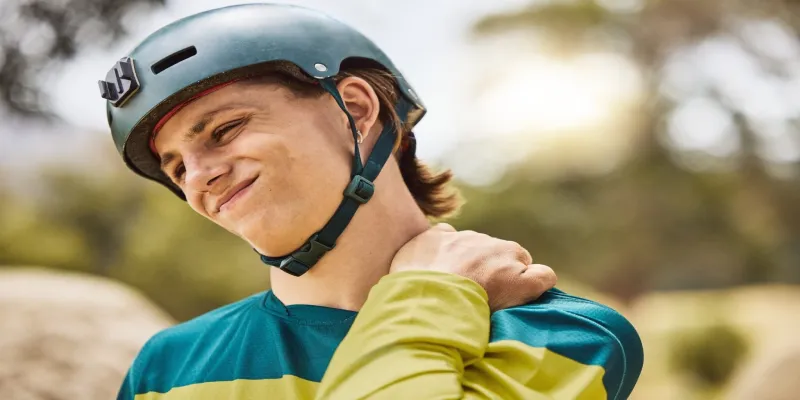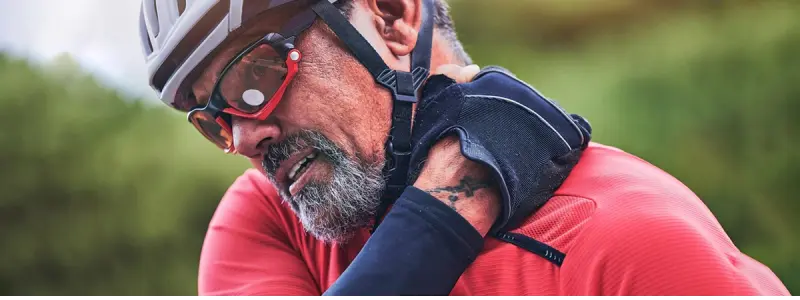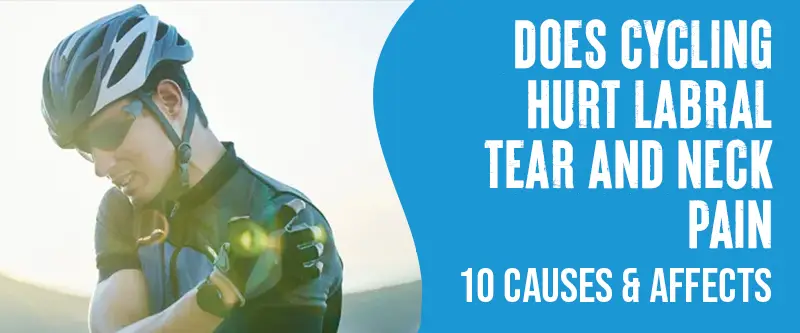Cycling can still cause or worsen a labrum tear if the bike is not fitted correctly, the posture is incorrect, or the intensity or duration of the ride is too high. Cycling can also aggravate a labrum tear if the rider has poor core stability, tight hip flexors, or weak gluteal muscles.
A labrum tear can cause neck pain if the injury affects the shoulder joint. This is because the shoulder and neck share some muscles and nerves that can transmit pain signals from one area to another. A shoulder labrum tear can also alter the biomechanics of the upper body and cause compensatory movements that strain the neck muscles.
In this article, we’ll explore how cycling can cause labrum tears and neck pain and how these issues might be related.
Does Cycling Hurt Labral Tear & Neck Pain: 10 Key Causes

One of the most common injuries among cyclists is a labrum tear, a tear or detachment in the cartilage cushioning the hip joint. Another common complaint is neck pain, resulting from the prolonged and awkward cycling posture. We will discuss how cycling can worsen or cause these conditions and how they can be related.
Cycling Can Cause or Worsen Labrum Tears: 7 Situations
A labrum surrounds the hip socket and helps stabilize and cushion the head of the femur (thigh bone). A labrum tear is a shared trauma, overuse, or cartilage degeneration injury. Labrum tears can cause hip pain, stiffness, clicking, locking, or catching sensations, sometimes radiating to the groin, buttock, or thigh.
Cycling is a popular sport and exercise that can have many benefits for the health and fitness of the body. Cycling can also pose some risks for the hip joint, especially for the labrum. Here are some ways that cycling can worsen or cause labrum tears:
- Cycling involves prolonged periods of hip flexion and rotation, which can stress the labrum and cause it to tear or detach from the socket’s rim. This can happen when the cyclist pedals with high resistance, high cadence, or low seat height or when the cyclist leans forward too much on the handlebars.
- Cycling can also aggravate existing labrum tears by increasing the friction and inflammation in the joint. It can occur when a cyclist rides long distances, on uneven terrain, or with poor posture or technique.
You can tear your labrum while cycling if you do the following:
- Sprinting requires sudden bursts of power and speed that can strain the hip muscles and tendons.
- Climbing involves high hip flexion and torque levels that can compress the labrum and the femoral head against the socket.
- Descending requires the cyclist to lean back and extend the hips, which can stretch the labrum and the ligaments that support the joint.
- Cornering involves leaning the bike and the body to one side, which can create shear forces on the labrum and the joint.
- Riding with a significant handlebar drop or a poorly fitted bike can force the cyclist to hunch over and flex the hips excessively, reducing the blood flow and oxygen to the joint and the cartilage.
How Labrum Tear Can Cause or Worsen Neck Pain: 3 Causes
The labrum tear can also affect other body parts, especially the neck. The neck is connected to the spine, which runs through the pelvis and the hips.
When the hip joint is injured or inflamed, it can cause changes in the alignment and the movement of the spine, which can then affect the neck. Here are some ways that a torn labrum can contribute to neck pain:
- Labrum tear can cause the hip muscles to tighten or spasm, which can pull on the lower back and the pelvis, creating tension and pressure in the spine. This can lead to poor posture, reduced mobility, and increased neck muscle and joint stress.
- Labrum tear can also cause the hip joint to become unstable or misaligned, altering the body’s gait and balance. This can cause the body to compensate by shifting the weight or leaning one way, causing asymmetry and strain in the spine and the neck.
- Labrum tears can also trigger a pain response that affects the nervous system and the brain, increasing the sensitivity and perception of pain in other areas of the body, such as the neck. This can make the neck more prone to inflammation, stiffness, and spasms, limiting the range of motion and function of the neck.
Effects of Cycling on Neck & Labrum
Cycling is a popular form of exercise and recreation enjoyed by many. Still, it’s essential to be aware of potential risks associated with this activity, including the possibility of a labrum tear leading to neck pain. Here, we’ll delve into some key effects.
Labral Tear Causing Neck Pain
The labrum is a piece of cartilage in the shoulder joint that helps stabilize the joint and keep it in place. Continuous stress and strain on the shoulder, common during cycling, can lead to overuse injuries, including labral tears. A labral tear can cause referred pain, leading to discomfort in the neck region.
Labral Tear Affecting the Trapezius
The trapezius muscle is a large muscle in the upper back and neck region that is heavily involved in cycling posture and stability.
When the labrum is injured, it can affect the stability of the shoulder joint, leading to compensatory movements and increased strain on surrounding muscles such as the trapezius. This increased strain can cause pain and discomfort in the neck area.
Labral Tear in the Shoulder affecting Nick Heath
The shoulder and neck are intricately connected through a network of muscles, tendons, and ligaments. A labral tear in the shoulder can disrupt this interconnected system, causing alterations in movement patterns and muscle activation.
These alterations can lead to imbalances and compensatory movements, resulting in neck pain and discomfort.
Labrum Tear and Neck Pain: How They Affect Cyclists?

Cycling enthusiasts often revel in the thrill of the ride, but it’s crucial to acknowledge the potential risks associated with poor posture and bike setup. Two common ailments that cyclists frequently encounter are labrum tear and neck pain. We’ll delve into the interconnected nature of these injuries and how they can impact your cycling experience.
Role of Posture and Bike Setup in Causing Injuries
Maintaining proper posture and optimizing your bike setup is paramount to preventing labrum tears and neck pain. These injuries often stem from biomechanical issues triggered by inadequate posture and ill-fitting bikes.
Signs of poor cycling posture include hunching over handlebars, tilting the head forward, and rounding the shoulders. These habits can lead to labrum inflammation and neck muscle tension, causing discomfort and pain. To mitigate these risks:
- Regularly assess and adjust your saddle height, angle, and position.
- Modify handlebar height, width, and reach to suit your body and riding style.
- Pay attention to the pedal position and cleat alignment.
- Periodically check your bike fit, as it can change with wear, tear, or changes in your body.
Consulting with a professional bike fitter or a cycling-specialized physiotherapist can provide valuable guidance.
Impact of Injuries on Performance & Comfort
Labrum tear and neck pain can significantly impact your cycling performance and comfort. These injuries manifest in symptoms such as limited range of motion, difficulty in arm movement, weakness, and tingling sensations. These symptoms hinder bike control and reduce overall enjoyment and motivation to ride.
Seeking prompt medical attention and adhering to professional advice are crucial for recovery. Treatment may involve rest, modified activities, or specific exercises to enhance strength and stability in the affected areas.
The Connection Between Injuries
Neck pain is linked to labrum tears beyond mere coincidence. They can co-occur or influence each other. Consider the following:
- Both injuries may co-occur, or one can exacerbate the other.
- Labrum tears can induce compensatory movements in the spine and shoulders, increasing stress on the neck.
- Neck pain can disrupt the balance and stability of the pelvis and hips, affecting shoulder alignment and function.
Addressing both injuries simultaneously is essential. Adopt a holistic approach by examining how posture, movement, and biomechanics affect your shoulder, neck, and vice versa. Consider factors like nutrition, hydration, sleep, stress, and emotions that may contribute to these injuries.
Conclusion
Now that you know more about how labrum tears and neck pain can affect your cycling experience, it’s time to take action and address these issues before they become chronic or severe.
Remember that prevention is critical, so always ensure your bike fits you properly, your posture is correct, and you warm up and cool down properly before and after each ride.
If you notice any signs of labrum tear or neck pain, don’t hesitate to seek professional advice and treatment, as early interventions can often lead to better outcomes.
FAQs
Can You Tell Me What Cyclist Neck Syndrome Is?
Cycling can lead to stiffness and pain in the upper trapezius and neck muscles over time. One of the critical areas of discomfort, along with muscular stiffness, is the cervico-thoracic junction. C/T junction is the knobbly area at the neck’s base and the thoracic spine’s top.
When A Labrum Is Torn, What Movements Hurt?
The most common symptoms of torn shoulder labrums are pain, instability, and catching, grinding, or locking of the shoulder during movement. It depends on the type of labral tear one has and whether they experiences these symptoms.


